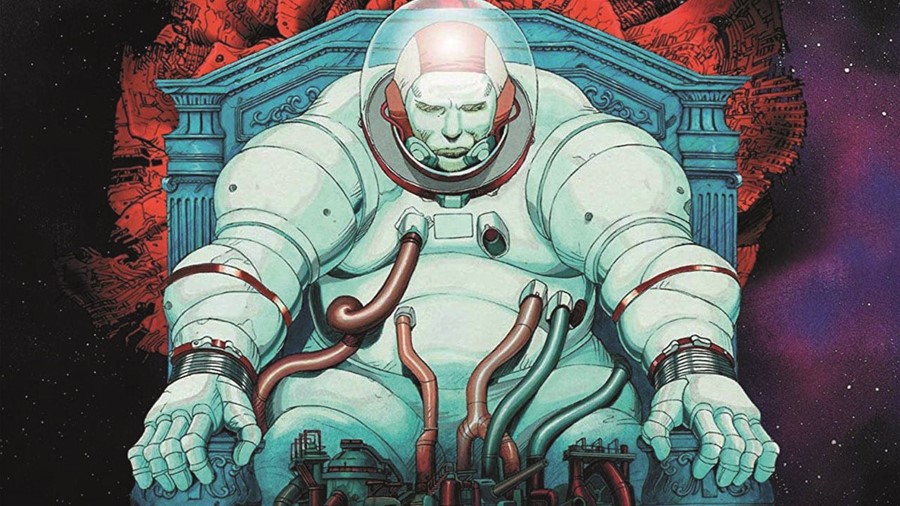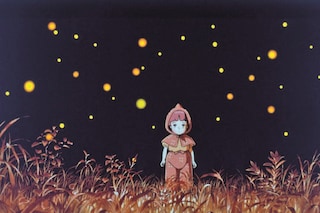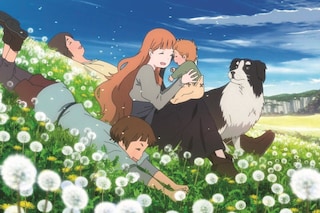A list of lesser-seen highlights from the BFI’s anime season, featuring Eiichi Yamamoto’s Belladonna of Sadness, Katsuhiro Otomo’s Memories, and Masaaki Yuasa’s Inu-Oh
The BFI’s extensive Japan 2021 retrospective – which commemorated over 100 years of Japanese cinema across a wealth of strands, genres and formats – reached its conclusion in January this year. But a much-welcomed epilogue will now launch at the end of this week. ‘Anime’ is a celebration of some of the country’s greatest cinematic exports, and this two-month season of animated programming will see both fan favourites and cult classics hit the silver screen in London from now all the way until the end of May.
Alongside classic Studio Ghibli fare including Princess Mononoke and Spirited Away, there are career-encompassing retrospectives on contemporary auteurs such as Makoto Shinkai (Your Name), Mamoru Hosoda (The Girl Who Leapt Through Time) and Satoshi Kon (Perfect Blue). Strands on women’s voices include Naoko Yamada’s 2016 film A Silent Voice, while the ‘History of Anime’ collection draws from works as far back as 1917. And obscure cult features and anthologies are intermixed with groundbreaking animation landmarks – as well as a series of previews showcasing what could be the next wave of definitive anime works.
Read on to explore a list of five lesser-seen highlights from five different decades, all of which contribute to what looks to be the anime event of the year in the UK.
BELLADONNA OF SADNESS, EIICHI YAMAMOTO (1973)
Director Eiichi Yamamoto, who sadly passed away in late 2021, initially made his name adapting works by the “godfather of manga” Osamu Tezuka for television and film in the 60s.
Astro Boy remains one of the most successful manga and anime franchises in the world, with over 100 million copies of the original manga series sold. Kimba the White Lion, meanwhile, would later be a considerable and controversial influence on Disney’s smash-hit The Lion King. (Film adaptions of both Japanese franchises can also be found elsewhere on the BFI Anime season programming.) As the 70s approached, though, and softcore “pink films” flooded Japan’s arthouse cinemas, Yamamoto and Tezuka pursued a decidedly different angle – with a trio of X-rated anime features collected under the banner Animerama.
A Thousand and One Nights (1969) had been a runaway success at the box office; Cleopatra (released as Cleopatra: Queen of Sex in the US; 1970) far less so. The third and final entry into the series retained the erotic themes and explicit imagery found in both its predecessors but ramped up the avant-garde experimentation via its use of pastel-hued watercolours and psychedelic dream sequences. Belladonna of Sadness (1973) was a catastrophic financial failure, nonetheless, and it bankrupted the production studio behind it.
Considered lost for years, this essentially feminist tale of rape, revenge and satanic demons in Middle Ages Europe received a loving restoration in 2015, and enjoys a cult following today. Much of the praise is been afforded to its surreal imagery, inspired by Gustav Klimt and Impressionist artists, and the symphonic psych-rock and acid jazz soundtrack by composer Masahiko Satoh.
PATLABOR: THE MOVIE, MAMORU OSHII (1989)
Cult anime filmmaker Mamoru Oshii is best known in the west for his 1995 classic Ghost In The Shell – arguably the greatest animated cyberpunk film ever made aside from 1988’s Akira. His 1989 feature Patlabor: The Movie, though, is an often overshadowed highlight that points to both of the aforementioned with its smashed concrete aesthetic, science fiction overtones and techno-mystery storyline.
In an imagined future set in 1999, Tokyo is largely dependent on giant industrial robots for a large-scale redevelopment project – until a suspicious defect coinciding with the unveiling of a new model of machine causes a number of “Labors” to act up. The consequence of this, as observed during the film’s chaotic opening act, is terror and destruction – and the Tokyo police force soon finds itself entwined in a plot involving a mysterious suicide, a devastating typhoon and heavy religious symbolism.
Parallels can be found in everything from the giant robots of Transformers to the techno-paranoia of classic science fiction films 2001: A Space Odyssey and The Terminator. But at the heart of the film is its vivid art style – which imbues construction site dystopias with delirious summer heat, contributing to an evocative atmosphere throughout. The film’s 1993 sequel, also by Oshii, can be found elsewhere during the BFI’s Anime season – and is arguably even better.
MEMORIES, KATSUHIRO OTOMO (1995)
Speaking of Akira, visionary director and manga artist Katsuhiro Otomo served as executive producer on this 1995 science fiction anthology film, which comprises three brilliant short films based on his own manga stories: Magnetic Rose, Stink Bomb and Cannon Fodder.
The former, directed by Koji Morimoto (The Animatrix), and based on a screenplay by Satoshi Kon (Perfect Blue), emphasises HR Giger-esque imagery as a freight spaceship floats through the cosmos. The ship’s crew is soon attracted to a mysterious SOS signal, landing on a satellite housing an opulent manor replete with banquet halls, lavish decor and lush, rolling gardens – as a psychological horror-mystery marrying the plots of Alien and Solaris soon unfolds. Stink Bomb then charts the fallout of a viral contagion in a scenic mountainside town – with nods to Dawn of the Dead aplenty.
Cannon Fodder, directed by Otomo himself, acts as a kind of missing link between Akira and the director’s 2004 steampunk feature, Steamboy (both of which also feature in the BFI’s Anime programming). Set within a walled city of the future lined with giant artillery cannons, where televised propaganda encourages citizens to “shoot and blast with all your strength for our nation!”, this vivid short fetishises images of steel, industry and militaristic warfare in a plot that recalls the dystopian classic 1984.
THE CASE OF HANA & ALICE, SHUNJI IWAI (2015)
Director Shunji Iwai is best known for his dreamy live-action works – like Japanese Academy Award winner Love Letter (1995), and the lyrical and elliptical cult classic All About Lily Chou-Chou (2001). The Case of Hana & Alice remains his only animated feature (it’s actually a prequel to his film Hana & Alice, shot over a decade earlier) – but its innovative hybrid-animation style makes it one of the most memorable works of his canon.
The film essentially concerns two high school girls who work together to uncover the truth behind a local tall tale: Alice (Yū Aoi)’s school desk, she learns, apparently once belonged to a boy named Judas who was allegedly killed by one of the four wives he later married. Quirky neighbour Hana (Anne Suzuki) helps Alice formulate a plan to discover what really happened to the missing student in this tender and funny coming-of-age youth drama.
Besides its obvious narrative charm and the whimsical piano-and-strings score (also by Iwai), it is the film’s visuals that make The Case of Hana & Alice so compelling. The film was created using rotoscoping – a technique in which live actors are filmed, and then the footage is replaced or traced over by animators, resulting in a rich and life-like hybrid animation style. In Iwai’s film, every scene feels intricate and full of detail – with the addition of a pink-and-purple lens flare that ensures that every shot is full of vibrancy and colour.
INU-OH, MASAAKI YUASA (2021)
An exclusive preview of Masaaki Yuasa’s Inu-Oh, which premiered at the Venice Film Festival in 2021, takes place on March 30 at the BFI ahead of a wider release expected in May. Set in 14th-century Japan, this historical-musical hybrid adapts the story of a physically deformed dancer (the titular Inu-Oh) dismissed as an “ugly monster” by townsfolk, who harbours dreams of becoming a famous performer. His struggle is shared with blind musician Tomona – whose artistic talents are similarly overshadowed by her own disability.
Inevitably, the duo become the talk of the town as members of an avant-garde performance arts troupe (“biwa and drums like you’ve never heard before!”, says one reveller) who reimagine traditional lute playing as groundbreaking rock and roll. Tales of warring clans and ghostly folklore are duly set to the sound of heavy riffs and solos (nods to Jimi Hendrix and Queen, included) in this imaginative love letter to a culturally significant period of Japanese history.









